Nuclear Regulations: Conduct of Operations, Safety Culture, and ISMS
VerifiedAdded on 2023/06/11
|10
|1569
|442
Homework Assignment
AI Summary
This assignment delves into the critical aspects of nuclear rules and regulations, focusing on Integrated Safety Management Systems (ISMS), conduct of operations, and safety culture within nuclear facilities. It addresses fundamental features of ISMS, highlighting the importance of safety plans, clear guidelines, personnel training, monitoring, supervision, and reporting protocols, while also exploring the benefits of ISMS implementation, such as improved efficiency, aligned operations, and stakeholder protection. The assignment further explains conduct of operations as structured operational and management tasks, emphasizing organizational roles, communication protocols, resource allocation, and hazard control, referencing governing federal regulations and IAEA safety guides. It also discusses the significance of lockout/tag out procedures in safeguarding employees and the public from unexpected energization or release of harmful materials, outlining essential elements for effective implementation. Additionally, the assignment differentiates between operator aids and procedures, emphasizing their complementary roles in ensuring efficient and safe operations. Finally, it examines the elements of a good work control process and the traits of a leader committed to safety values and actions, highlighting the importance of problem identification, personal accountability, continuous learning, and a respectful work environment. This document is available on Desklib, a platform offering a range of study tools and resources for students.
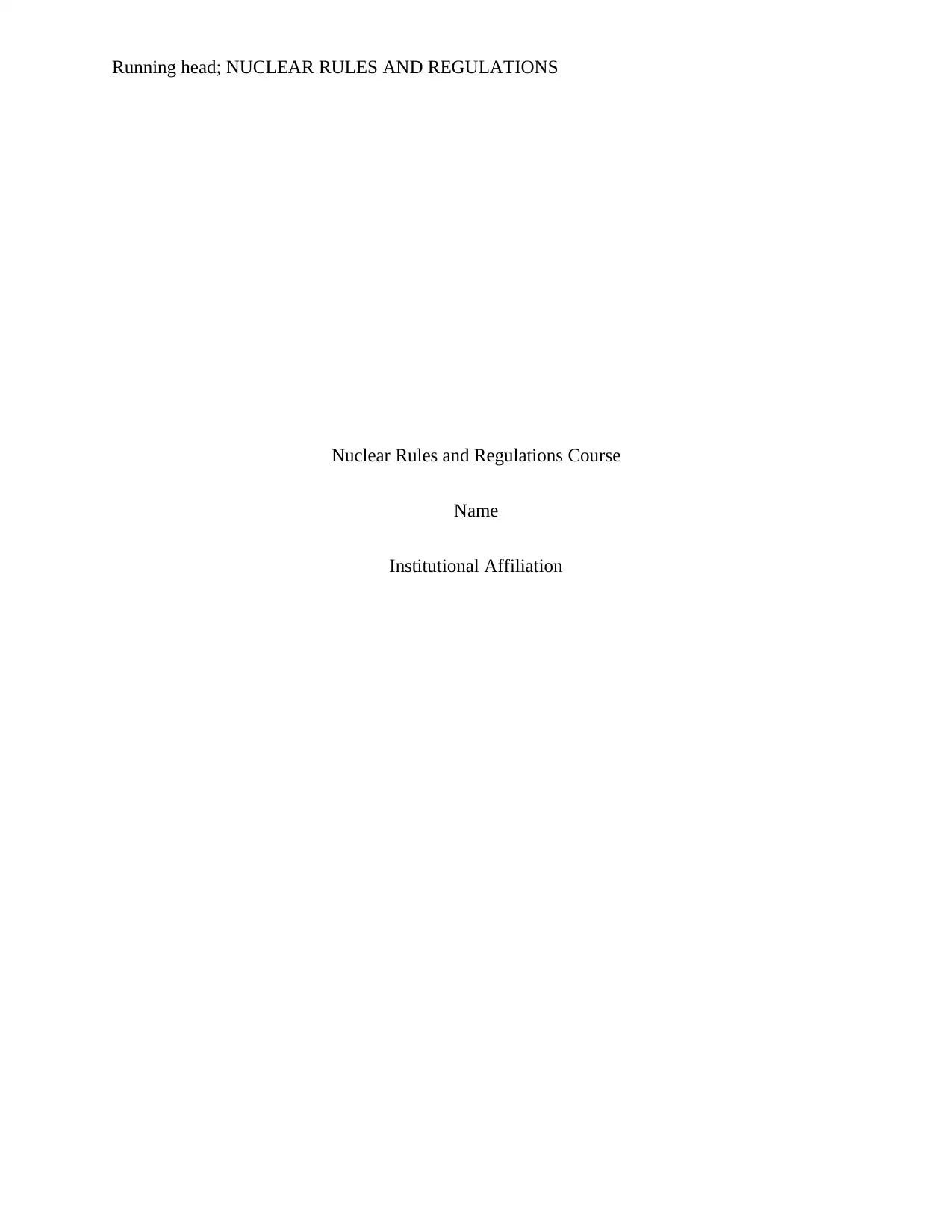
Running head; NUCLEAR RULES AND REGULATIONS
Nuclear Rules and Regulations Course
Name
Institutional Affiliation
Nuclear Rules and Regulations Course
Name
Institutional Affiliation
Paraphrase This Document
Need a fresh take? Get an instant paraphrase of this document with our AI Paraphraser
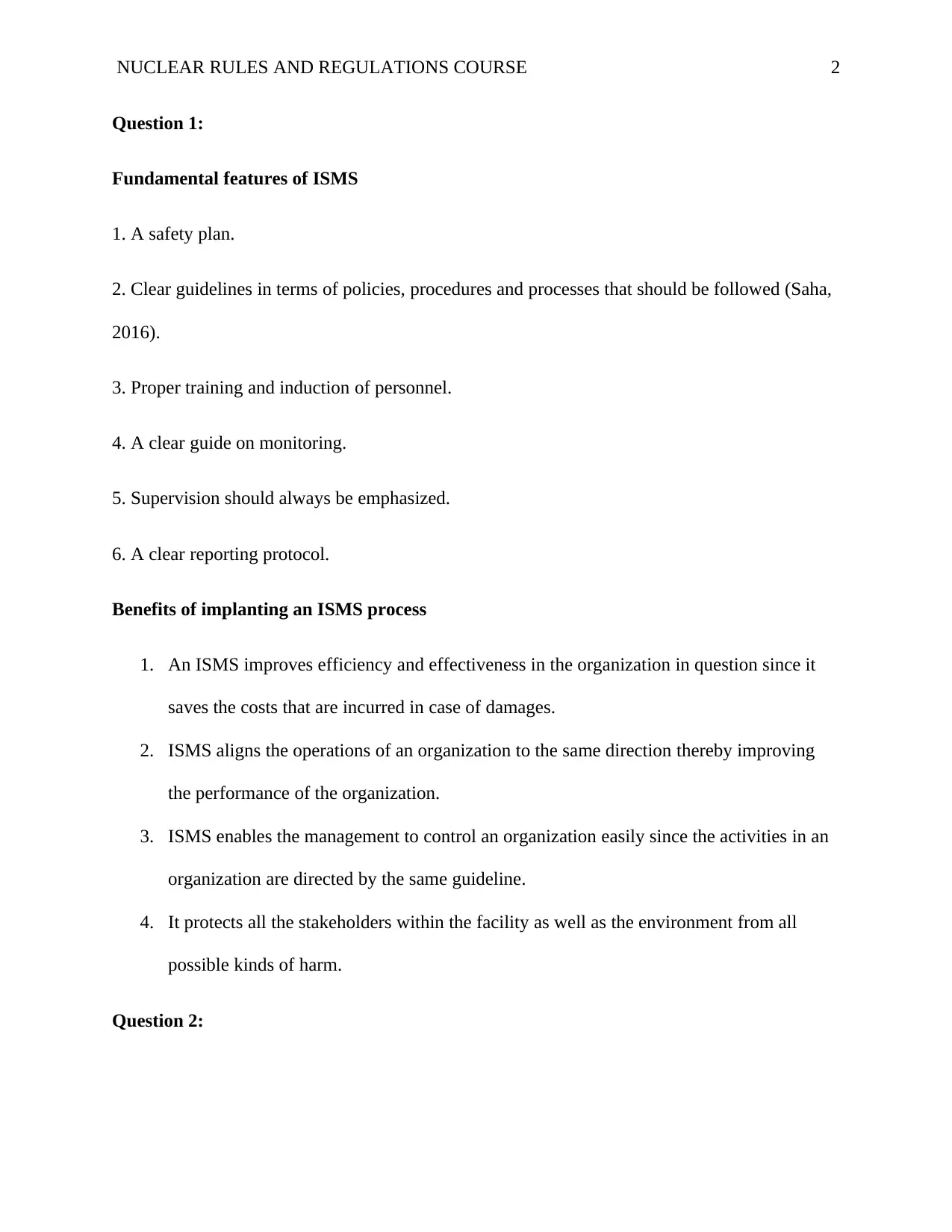
NUCLEAR RULES AND REGULATIONS COURSE 2
Question 1:
Fundamental features of ISMS
1. A safety plan.
2. Clear guidelines in terms of policies, procedures and processes that should be followed (Saha,
2016).
3. Proper training and induction of personnel.
4. A clear guide on monitoring.
5. Supervision should always be emphasized.
6. A clear reporting protocol.
Benefits of implanting an ISMS process
1. An ISMS improves efficiency and effectiveness in the organization in question since it
saves the costs that are incurred in case of damages.
2. ISMS aligns the operations of an organization to the same direction thereby improving
the performance of the organization.
3. ISMS enables the management to control an organization easily since the activities in an
organization are directed by the same guideline.
4. It protects all the stakeholders within the facility as well as the environment from all
possible kinds of harm.
Question 2:
Question 1:
Fundamental features of ISMS
1. A safety plan.
2. Clear guidelines in terms of policies, procedures and processes that should be followed (Saha,
2016).
3. Proper training and induction of personnel.
4. A clear guide on monitoring.
5. Supervision should always be emphasized.
6. A clear reporting protocol.
Benefits of implanting an ISMS process
1. An ISMS improves efficiency and effectiveness in the organization in question since it
saves the costs that are incurred in case of damages.
2. ISMS aligns the operations of an organization to the same direction thereby improving
the performance of the organization.
3. ISMS enables the management to control an organization easily since the activities in an
organization are directed by the same guideline.
4. It protects all the stakeholders within the facility as well as the environment from all
possible kinds of harm.
Question 2:
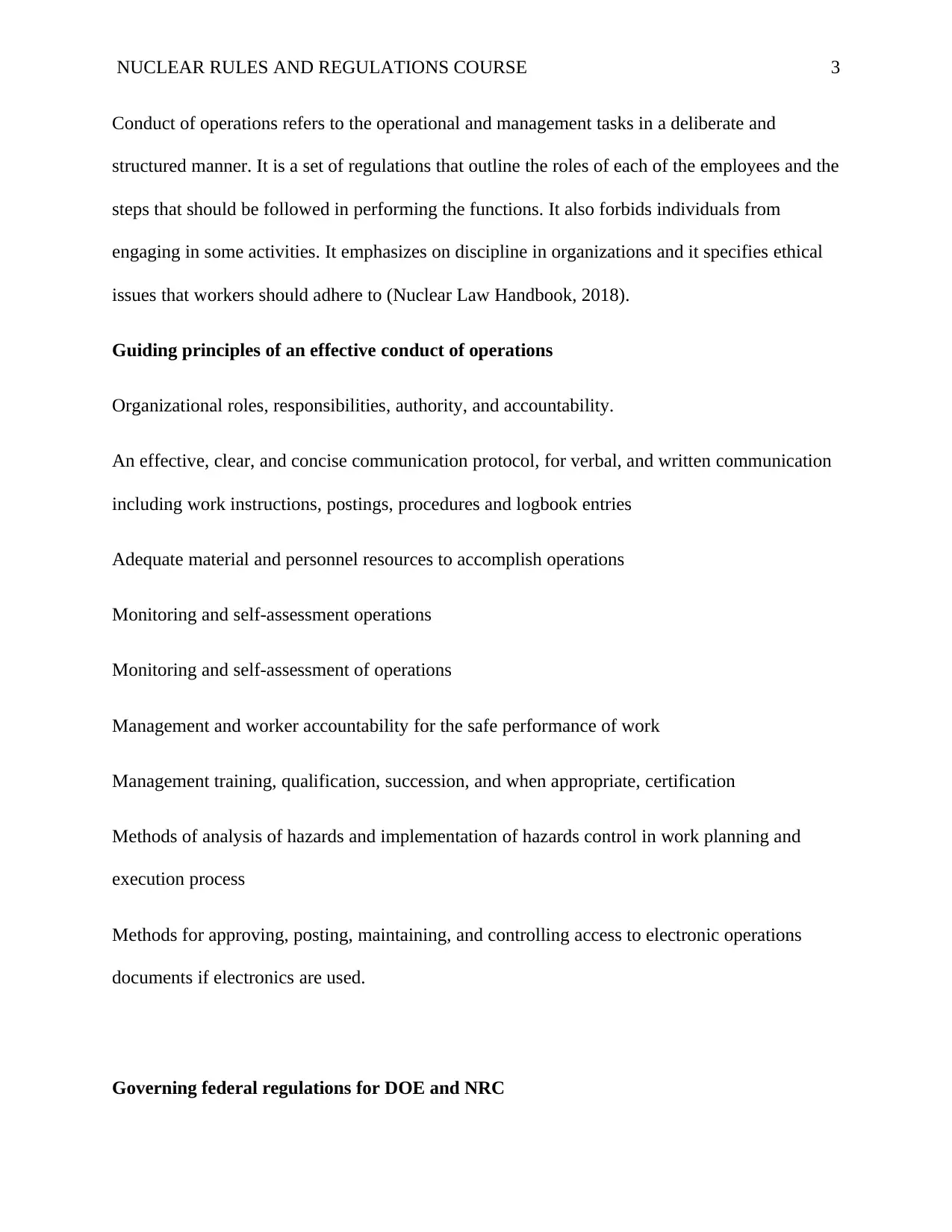
NUCLEAR RULES AND REGULATIONS COURSE 3
Conduct of operations refers to the operational and management tasks in a deliberate and
structured manner. It is a set of regulations that outline the roles of each of the employees and the
steps that should be followed in performing the functions. It also forbids individuals from
engaging in some activities. It emphasizes on discipline in organizations and it specifies ethical
issues that workers should adhere to (Nuclear Law Handbook, 2018).
Guiding principles of an effective conduct of operations
Organizational roles, responsibilities, authority, and accountability.
An effective, clear, and concise communication protocol, for verbal, and written communication
including work instructions, postings, procedures and logbook entries
Adequate material and personnel resources to accomplish operations
Monitoring and self-assessment operations
Monitoring and self-assessment of operations
Management and worker accountability for the safe performance of work
Management training, qualification, succession, and when appropriate, certification
Methods of analysis of hazards and implementation of hazards control in work planning and
execution process
Methods for approving, posting, maintaining, and controlling access to electronic operations
documents if electronics are used.
Governing federal regulations for DOE and NRC
Conduct of operations refers to the operational and management tasks in a deliberate and
structured manner. It is a set of regulations that outline the roles of each of the employees and the
steps that should be followed in performing the functions. It also forbids individuals from
engaging in some activities. It emphasizes on discipline in organizations and it specifies ethical
issues that workers should adhere to (Nuclear Law Handbook, 2018).
Guiding principles of an effective conduct of operations
Organizational roles, responsibilities, authority, and accountability.
An effective, clear, and concise communication protocol, for verbal, and written communication
including work instructions, postings, procedures and logbook entries
Adequate material and personnel resources to accomplish operations
Monitoring and self-assessment operations
Monitoring and self-assessment of operations
Management and worker accountability for the safe performance of work
Management training, qualification, succession, and when appropriate, certification
Methods of analysis of hazards and implementation of hazards control in work planning and
execution process
Methods for approving, posting, maintaining, and controlling access to electronic operations
documents if electronics are used.
Governing federal regulations for DOE and NRC
⊘ This is a preview!⊘
Do you want full access?
Subscribe today to unlock all pages.

Trusted by 1+ million students worldwide
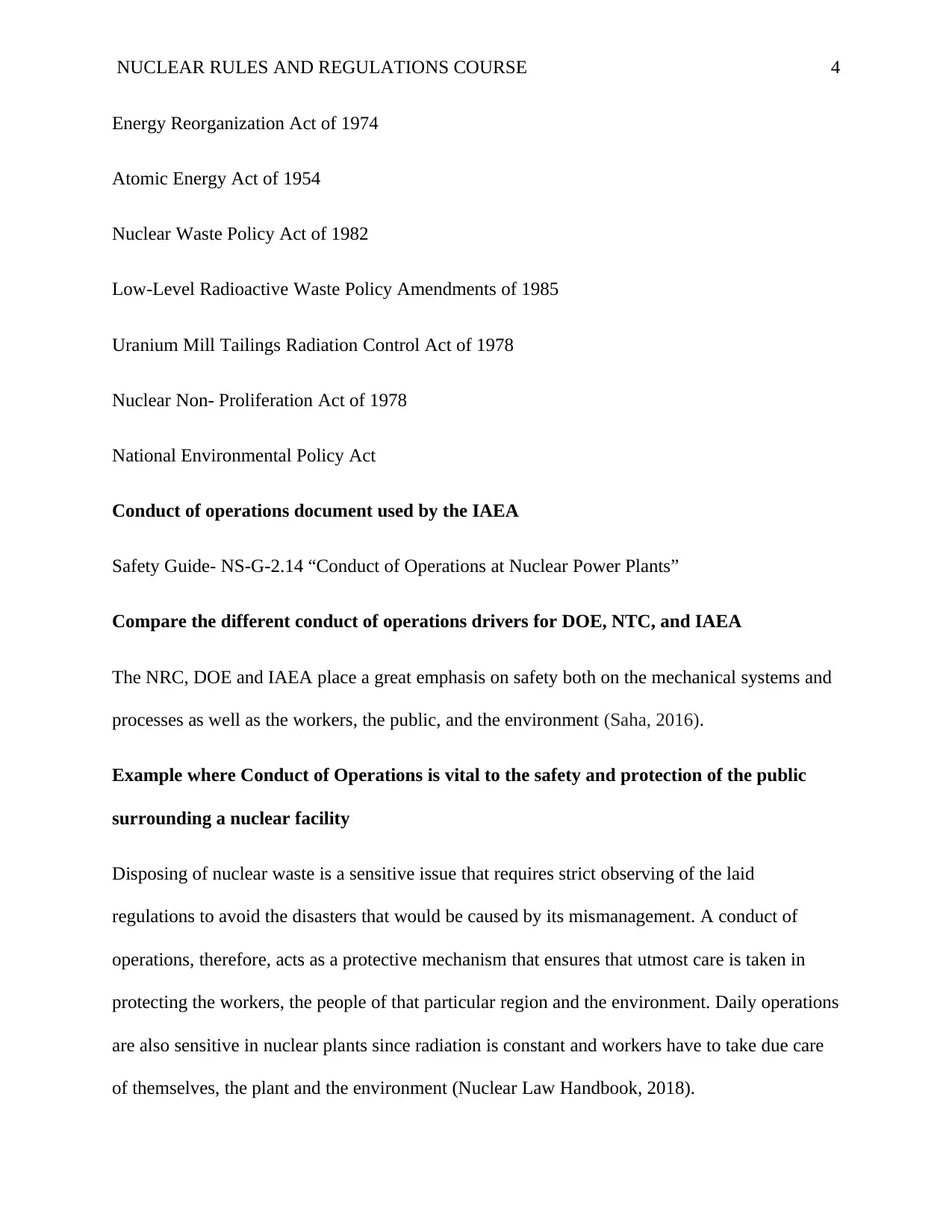
NUCLEAR RULES AND REGULATIONS COURSE 4
Energy Reorganization Act of 1974
Atomic Energy Act of 1954
Nuclear Waste Policy Act of 1982
Low-Level Radioactive Waste Policy Amendments of 1985
Uranium Mill Tailings Radiation Control Act of 1978
Nuclear Non- Proliferation Act of 1978
National Environmental Policy Act
Conduct of operations document used by the IAEA
Safety Guide- NS-G-2.14 “Conduct of Operations at Nuclear Power Plants”
Compare the different conduct of operations drivers for DOE, NTC, and IAEA
The NRC, DOE and IAEA place a great emphasis on safety both on the mechanical systems and
processes as well as the workers, the public, and the environment (Saha, 2016).
Example where Conduct of Operations is vital to the safety and protection of the public
surrounding a nuclear facility
Disposing of nuclear waste is a sensitive issue that requires strict observing of the laid
regulations to avoid the disasters that would be caused by its mismanagement. A conduct of
operations, therefore, acts as a protective mechanism that ensures that utmost care is taken in
protecting the workers, the people of that particular region and the environment. Daily operations
are also sensitive in nuclear plants since radiation is constant and workers have to take due care
of themselves, the plant and the environment (Nuclear Law Handbook, 2018).
Energy Reorganization Act of 1974
Atomic Energy Act of 1954
Nuclear Waste Policy Act of 1982
Low-Level Radioactive Waste Policy Amendments of 1985
Uranium Mill Tailings Radiation Control Act of 1978
Nuclear Non- Proliferation Act of 1978
National Environmental Policy Act
Conduct of operations document used by the IAEA
Safety Guide- NS-G-2.14 “Conduct of Operations at Nuclear Power Plants”
Compare the different conduct of operations drivers for DOE, NTC, and IAEA
The NRC, DOE and IAEA place a great emphasis on safety both on the mechanical systems and
processes as well as the workers, the public, and the environment (Saha, 2016).
Example where Conduct of Operations is vital to the safety and protection of the public
surrounding a nuclear facility
Disposing of nuclear waste is a sensitive issue that requires strict observing of the laid
regulations to avoid the disasters that would be caused by its mismanagement. A conduct of
operations, therefore, acts as a protective mechanism that ensures that utmost care is taken in
protecting the workers, the people of that particular region and the environment. Daily operations
are also sensitive in nuclear plants since radiation is constant and workers have to take due care
of themselves, the plant and the environment (Nuclear Law Handbook, 2018).
Paraphrase This Document
Need a fresh take? Get an instant paraphrase of this document with our AI Paraphraser
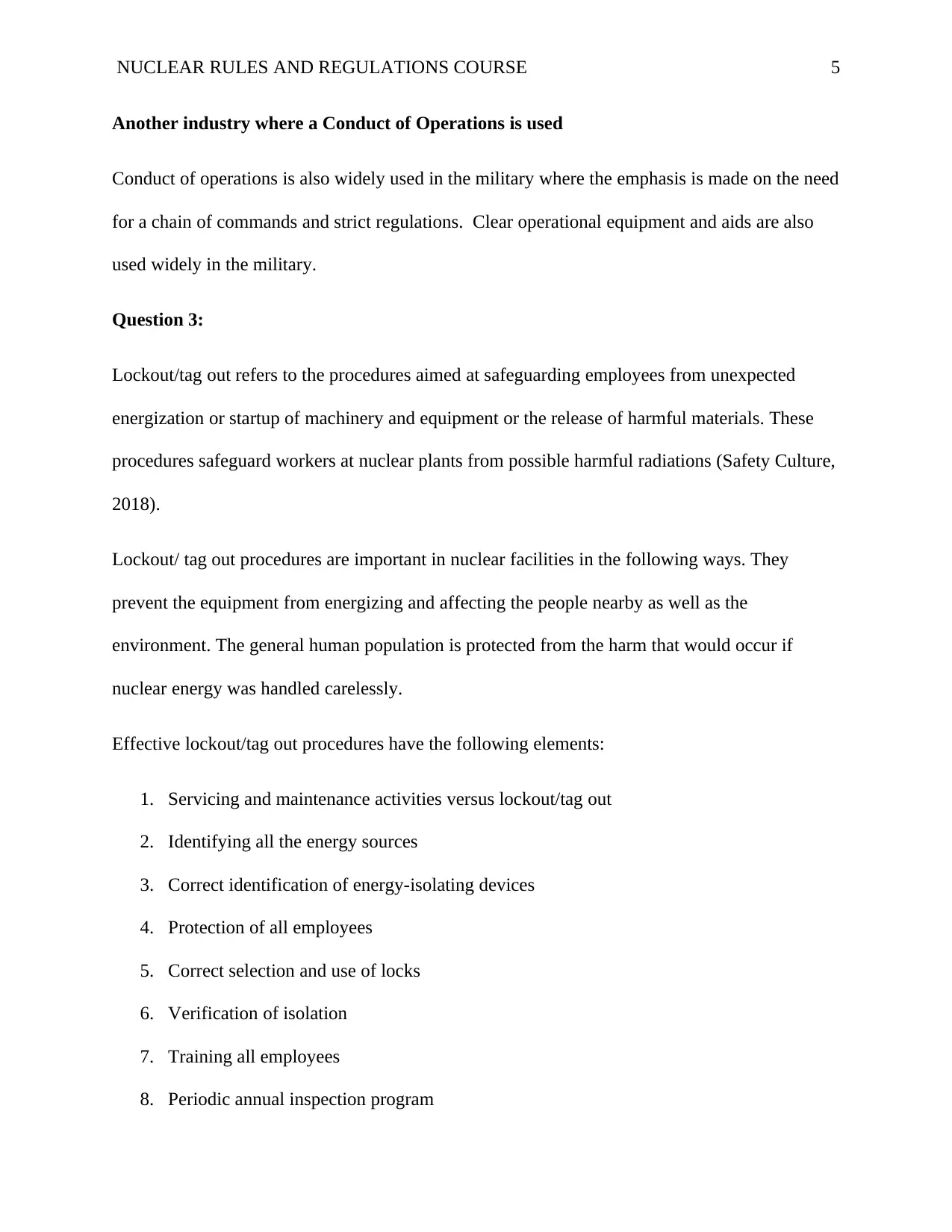
NUCLEAR RULES AND REGULATIONS COURSE 5
Another industry where a Conduct of Operations is used
Conduct of operations is also widely used in the military where the emphasis is made on the need
for a chain of commands and strict regulations. Clear operational equipment and aids are also
used widely in the military.
Question 3:
Lockout/tag out refers to the procedures aimed at safeguarding employees from unexpected
energization or startup of machinery and equipment or the release of harmful materials. These
procedures safeguard workers at nuclear plants from possible harmful radiations (Safety Culture,
2018).
Lockout/ tag out procedures are important in nuclear facilities in the following ways. They
prevent the equipment from energizing and affecting the people nearby as well as the
environment. The general human population is protected from the harm that would occur if
nuclear energy was handled carelessly.
Effective lockout/tag out procedures have the following elements:
1. Servicing and maintenance activities versus lockout/tag out
2. Identifying all the energy sources
3. Correct identification of energy-isolating devices
4. Protection of all employees
5. Correct selection and use of locks
6. Verification of isolation
7. Training all employees
8. Periodic annual inspection program
Another industry where a Conduct of Operations is used
Conduct of operations is also widely used in the military where the emphasis is made on the need
for a chain of commands and strict regulations. Clear operational equipment and aids are also
used widely in the military.
Question 3:
Lockout/tag out refers to the procedures aimed at safeguarding employees from unexpected
energization or startup of machinery and equipment or the release of harmful materials. These
procedures safeguard workers at nuclear plants from possible harmful radiations (Safety Culture,
2018).
Lockout/ tag out procedures are important in nuclear facilities in the following ways. They
prevent the equipment from energizing and affecting the people nearby as well as the
environment. The general human population is protected from the harm that would occur if
nuclear energy was handled carelessly.
Effective lockout/tag out procedures have the following elements:
1. Servicing and maintenance activities versus lockout/tag out
2. Identifying all the energy sources
3. Correct identification of energy-isolating devices
4. Protection of all employees
5. Correct selection and use of locks
6. Verification of isolation
7. Training all employees
8. Periodic annual inspection program
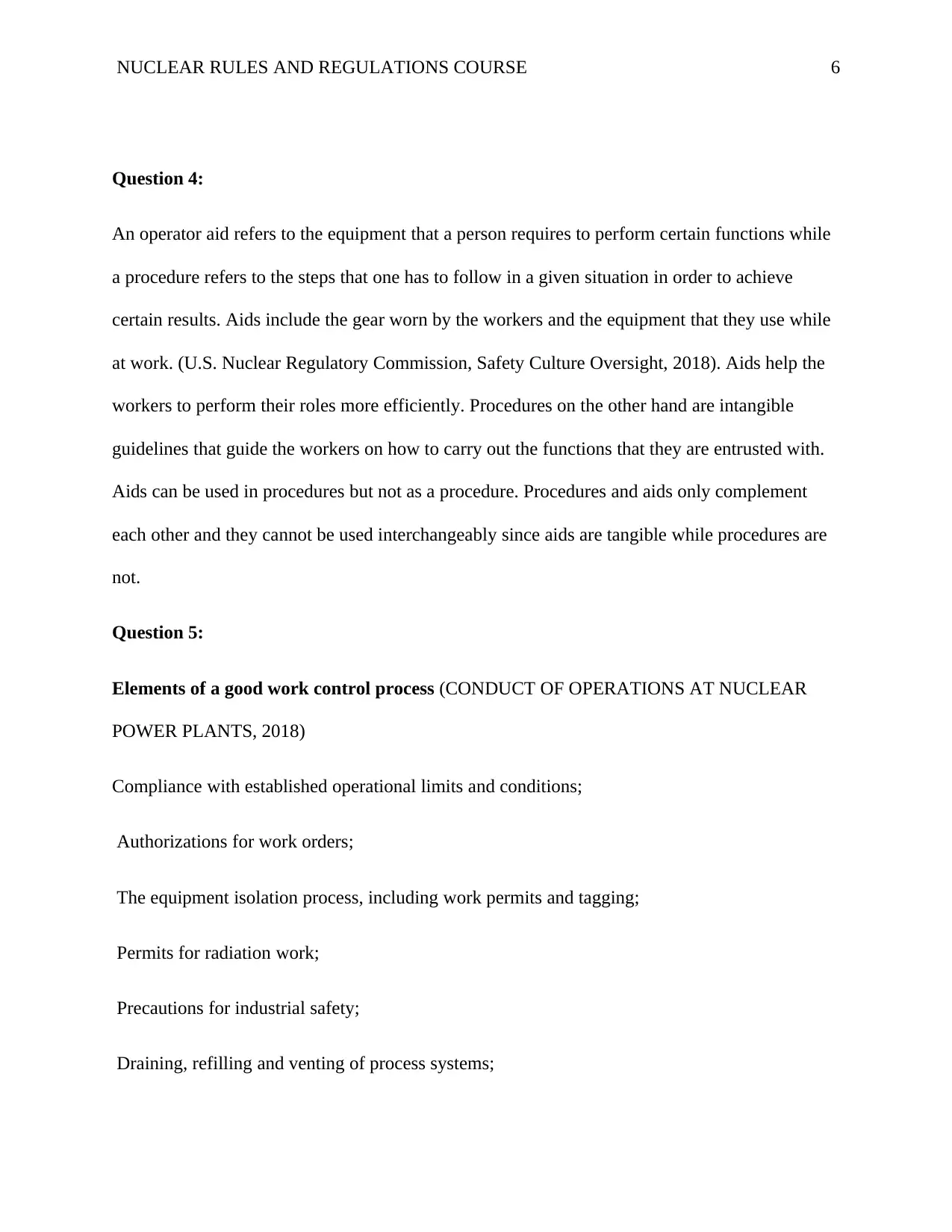
NUCLEAR RULES AND REGULATIONS COURSE 6
Question 4:
An operator aid refers to the equipment that a person requires to perform certain functions while
a procedure refers to the steps that one has to follow in a given situation in order to achieve
certain results. Aids include the gear worn by the workers and the equipment that they use while
at work. (U.S. Nuclear Regulatory Commission, Safety Culture Oversight, 2018). Aids help the
workers to perform their roles more efficiently. Procedures on the other hand are intangible
guidelines that guide the workers on how to carry out the functions that they are entrusted with.
Aids can be used in procedures but not as a procedure. Procedures and aids only complement
each other and they cannot be used interchangeably since aids are tangible while procedures are
not.
Question 5:
Elements of a good work control process (CONDUCT OF OPERATIONS AT NUCLEAR
POWER PLANTS, 2018)
Compliance with established operational limits and conditions;
Authorizations for work orders;
The equipment isolation process, including work permits and tagging;
Permits for radiation work;
Precautions for industrial safety;
Draining, refilling and venting of process systems;
Question 4:
An operator aid refers to the equipment that a person requires to perform certain functions while
a procedure refers to the steps that one has to follow in a given situation in order to achieve
certain results. Aids include the gear worn by the workers and the equipment that they use while
at work. (U.S. Nuclear Regulatory Commission, Safety Culture Oversight, 2018). Aids help the
workers to perform their roles more efficiently. Procedures on the other hand are intangible
guidelines that guide the workers on how to carry out the functions that they are entrusted with.
Aids can be used in procedures but not as a procedure. Procedures and aids only complement
each other and they cannot be used interchangeably since aids are tangible while procedures are
not.
Question 5:
Elements of a good work control process (CONDUCT OF OPERATIONS AT NUCLEAR
POWER PLANTS, 2018)
Compliance with established operational limits and conditions;
Authorizations for work orders;
The equipment isolation process, including work permits and tagging;
Permits for radiation work;
Precautions for industrial safety;
Draining, refilling and venting of process systems;
⊘ This is a preview!⊘
Do you want full access?
Subscribe today to unlock all pages.

Trusted by 1+ million students worldwide
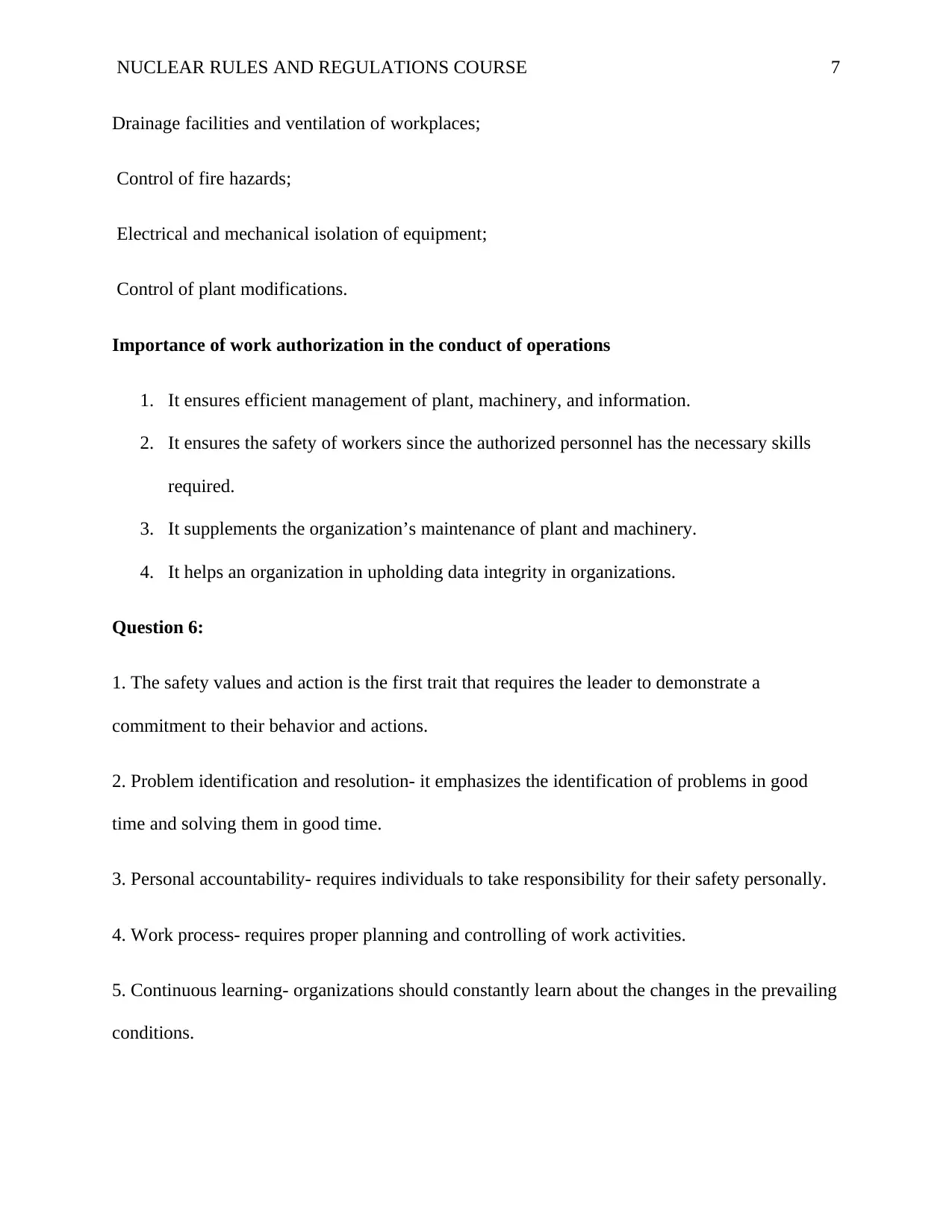
NUCLEAR RULES AND REGULATIONS COURSE 7
Drainage facilities and ventilation of workplaces;
Control of fire hazards;
Electrical and mechanical isolation of equipment;
Control of plant modifications.
Importance of work authorization in the conduct of operations
1. It ensures efficient management of plant, machinery, and information.
2. It ensures the safety of workers since the authorized personnel has the necessary skills
required.
3. It supplements the organization’s maintenance of plant and machinery.
4. It helps an organization in upholding data integrity in organizations.
Question 6:
1. The safety values and action is the first trait that requires the leader to demonstrate a
commitment to their behavior and actions.
2. Problem identification and resolution- it emphasizes the identification of problems in good
time and solving them in good time.
3. Personal accountability- requires individuals to take responsibility for their safety personally.
4. Work process- requires proper planning and controlling of work activities.
5. Continuous learning- organizations should constantly learn about the changes in the prevailing
conditions.
Drainage facilities and ventilation of workplaces;
Control of fire hazards;
Electrical and mechanical isolation of equipment;
Control of plant modifications.
Importance of work authorization in the conduct of operations
1. It ensures efficient management of plant, machinery, and information.
2. It ensures the safety of workers since the authorized personnel has the necessary skills
required.
3. It supplements the organization’s maintenance of plant and machinery.
4. It helps an organization in upholding data integrity in organizations.
Question 6:
1. The safety values and action is the first trait that requires the leader to demonstrate a
commitment to their behavior and actions.
2. Problem identification and resolution- it emphasizes the identification of problems in good
time and solving them in good time.
3. Personal accountability- requires individuals to take responsibility for their safety personally.
4. Work process- requires proper planning and controlling of work activities.
5. Continuous learning- organizations should constantly learn about the changes in the prevailing
conditions.
Paraphrase This Document
Need a fresh take? Get an instant paraphrase of this document with our AI Paraphraser
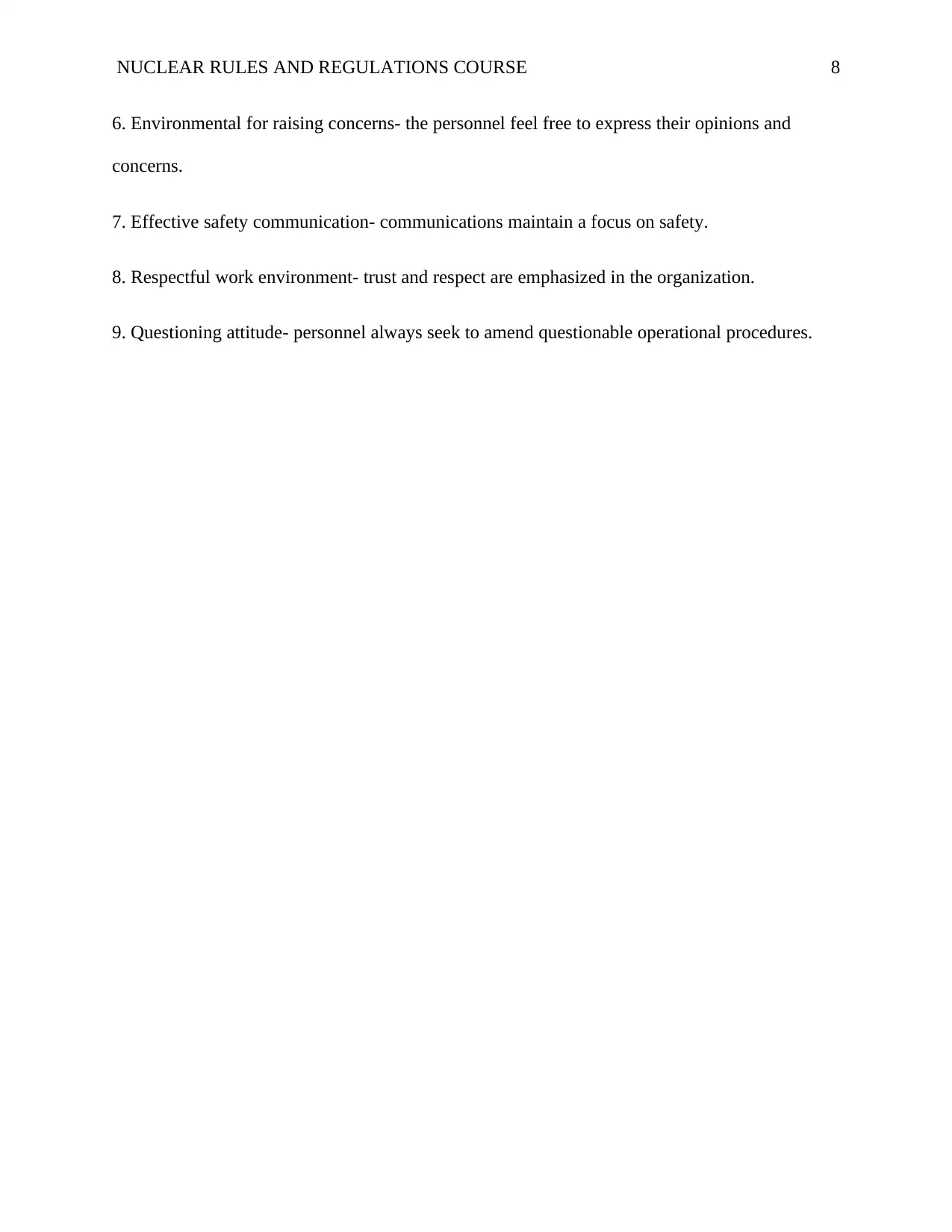
NUCLEAR RULES AND REGULATIONS COURSE 8
6. Environmental for raising concerns- the personnel feel free to express their opinions and
concerns.
7. Effective safety communication- communications maintain a focus on safety.
8. Respectful work environment- trust and respect are emphasized in the organization.
9. Questioning attitude- personnel always seek to amend questionable operational procedures.
6. Environmental for raising concerns- the personnel feel free to express their opinions and
concerns.
7. Effective safety communication- communications maintain a focus on safety.
8. Respectful work environment- trust and respect are emphasized in the organization.
9. Questioning attitude- personnel always seek to amend questionable operational procedures.
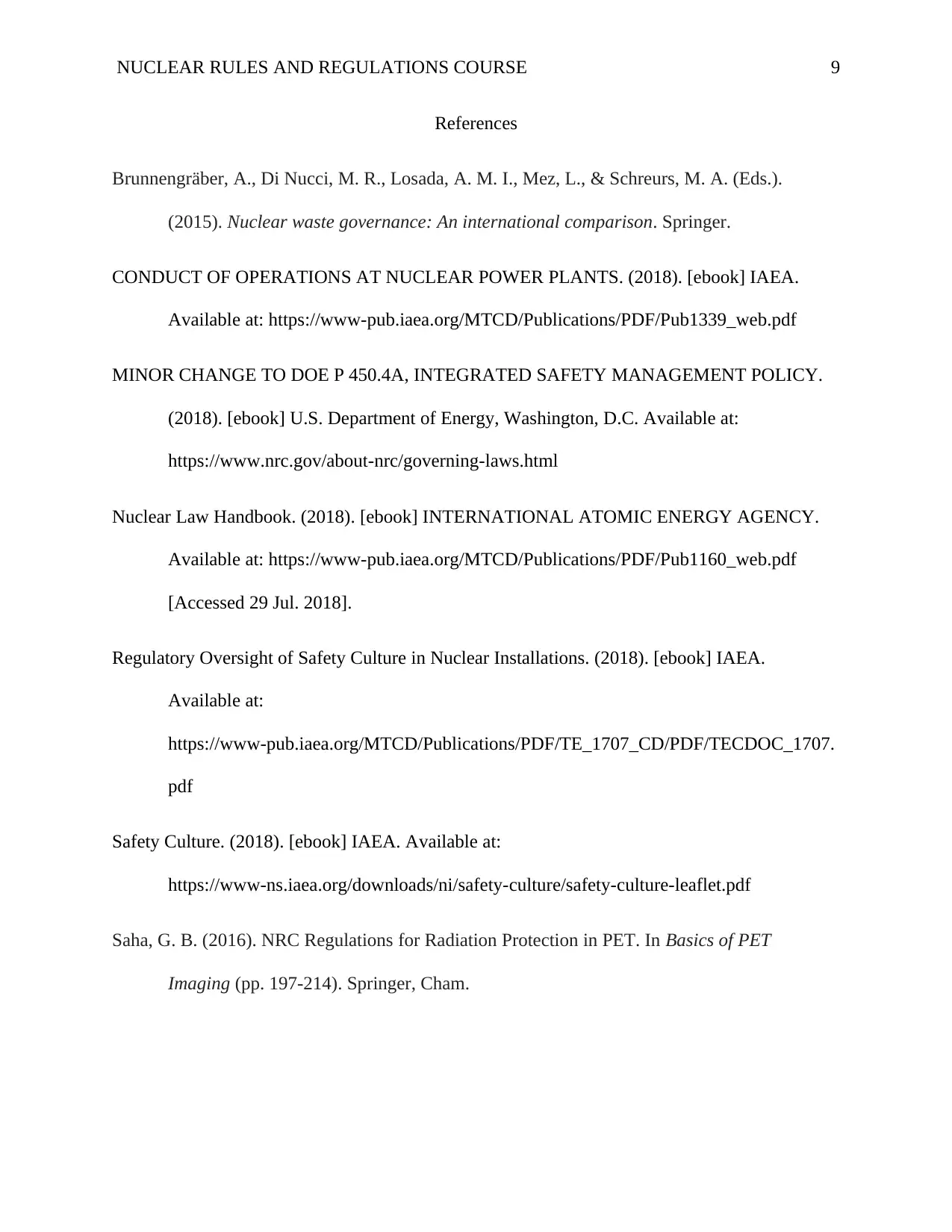
NUCLEAR RULES AND REGULATIONS COURSE 9
References
Brunnengräber, A., Di Nucci, M. R., Losada, A. M. I., Mez, L., & Schreurs, M. A. (Eds.).
(2015). Nuclear waste governance: An international comparison. Springer.
CONDUCT OF OPERATIONS AT NUCLEAR POWER PLANTS. (2018). [ebook] IAEA.
Available at: https://www-pub.iaea.org/MTCD/Publications/PDF/Pub1339_web.pdf
MINOR CHANGE TO DOE P 450.4A, INTEGRATED SAFETY MANAGEMENT POLICY.
(2018). [ebook] U.S. Department of Energy, Washington, D.C. Available at:
https://www.nrc.gov/about-nrc/governing-laws.html
Nuclear Law Handbook. (2018). [ebook] INTERNATIONAL ATOMIC ENERGY AGENCY.
Available at: https://www-pub.iaea.org/MTCD/Publications/PDF/Pub1160_web.pdf
[Accessed 29 Jul. 2018].
Regulatory Oversight of Safety Culture in Nuclear Installations. (2018). [ebook] IAEA.
Available at:
https://www-pub.iaea.org/MTCD/Publications/PDF/TE_1707_CD/PDF/TECDOC_1707.
pdf
Safety Culture. (2018). [ebook] IAEA. Available at:
https://www-ns.iaea.org/downloads/ni/safety-culture/safety-culture-leaflet.pdf
Saha, G. B. (2016). NRC Regulations for Radiation Protection in PET. In Basics of PET
Imaging (pp. 197-214). Springer, Cham.
References
Brunnengräber, A., Di Nucci, M. R., Losada, A. M. I., Mez, L., & Schreurs, M. A. (Eds.).
(2015). Nuclear waste governance: An international comparison. Springer.
CONDUCT OF OPERATIONS AT NUCLEAR POWER PLANTS. (2018). [ebook] IAEA.
Available at: https://www-pub.iaea.org/MTCD/Publications/PDF/Pub1339_web.pdf
MINOR CHANGE TO DOE P 450.4A, INTEGRATED SAFETY MANAGEMENT POLICY.
(2018). [ebook] U.S. Department of Energy, Washington, D.C. Available at:
https://www.nrc.gov/about-nrc/governing-laws.html
Nuclear Law Handbook. (2018). [ebook] INTERNATIONAL ATOMIC ENERGY AGENCY.
Available at: https://www-pub.iaea.org/MTCD/Publications/PDF/Pub1160_web.pdf
[Accessed 29 Jul. 2018].
Regulatory Oversight of Safety Culture in Nuclear Installations. (2018). [ebook] IAEA.
Available at:
https://www-pub.iaea.org/MTCD/Publications/PDF/TE_1707_CD/PDF/TECDOC_1707.
Safety Culture. (2018). [ebook] IAEA. Available at:
https://www-ns.iaea.org/downloads/ni/safety-culture/safety-culture-leaflet.pdf
Saha, G. B. (2016). NRC Regulations for Radiation Protection in PET. In Basics of PET
Imaging (pp. 197-214). Springer, Cham.
⊘ This is a preview!⊘
Do you want full access?
Subscribe today to unlock all pages.

Trusted by 1+ million students worldwide
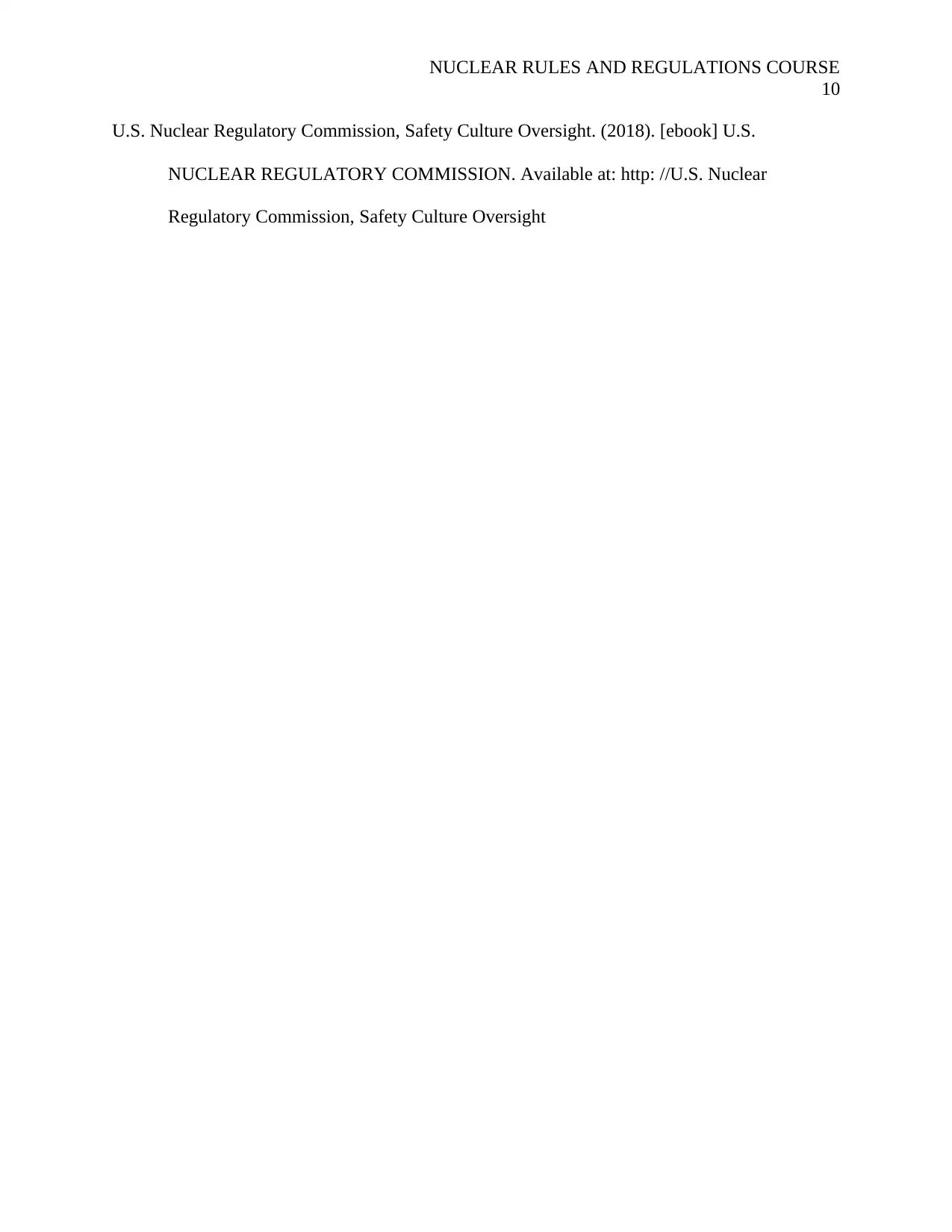
NUCLEAR RULES AND REGULATIONS COURSE
10
U.S. Nuclear Regulatory Commission, Safety Culture Oversight. (2018). [ebook] U.S.
NUCLEAR REGULATORY COMMISSION. Available at: http: //U.S. Nuclear
Regulatory Commission, Safety Culture Oversight
10
U.S. Nuclear Regulatory Commission, Safety Culture Oversight. (2018). [ebook] U.S.
NUCLEAR REGULATORY COMMISSION. Available at: http: //U.S. Nuclear
Regulatory Commission, Safety Culture Oversight
1 out of 10
Related Documents
Your All-in-One AI-Powered Toolkit for Academic Success.
+13062052269
info@desklib.com
Available 24*7 on WhatsApp / Email
![[object Object]](/_next/static/media/star-bottom.7253800d.svg)
Unlock your academic potential
Copyright © 2020–2025 A2Z Services. All Rights Reserved. Developed and managed by ZUCOL.





